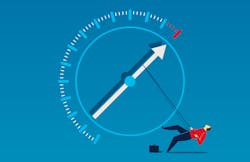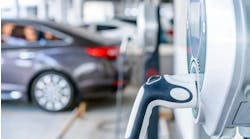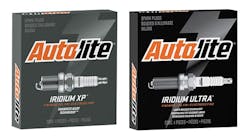When Dave McClung moved into his shop’s new facility in 2014, despite the location being in a better, more populated area than before, he was faced with one major problem: its miniscule size.
Now based in Lakewood, N.J., Autobahn Automotive has 2,343 square feet of space in its building, with just 1,880 square feet of shop space, significantly less than the 2,500 square feet he had to work with at his previous shop. It has just one bay door, and McClung eventually had to cram in three lifts and an alignment rack.
“I said, if we can break even for a few years and figure out how to do it, at least we can stay afloat. I’m happy with that,” McClung says.
The sales kept climbing as McClung adapted to his new environment, and revenue has increased from $623,000 in 2014, to $1.05 million in 2018.
As business started to turn around, McClung had to instill lean processes that would maximize his shop’s efficiency, and put an emphasis on staff communication and teamwork.
Working in a Circle
With the way his shop runs now, McClung compares the workflow process to a circle. It can expand or contract as needed but retains its general shape, so no processes are lost if the team happens to be short staffed.
When he first saw the shop, he had to map everything out on a CAD file. There was only one bay door in and out, and it was at a 90-degree angle where an alignment rack would have to be turned to get the car out. McClung had to make sure this could work with other lifts in the way, along with oil, garbage cans and desks.
As his staff grew, McClung had to expedite his repair process, and find a way to where repairs could get done quickly and efficiently in the small space. Whenever a car comes in the shop, the staff follows a streamlined process, detailing specific duties for each employee, from service advisors to technicians.
Technicians often work in unison, and McClung always wants to see his technicians working two at a time on each car. A significant part of keeping everything team oriented and keeping everyone motivated is McClung’s team-based pay plan.
He put this together based on his own experiences working as a flat-rate technician, believing that a team-based pay plan would create a much better environment.
“When I started as a flat-rate tech, I knew how to dummy the system. I would be out for myself and it wasn’t a very good environment,” McClung says. “I didn’t want to hire a tech like me.”
The team has a tiered bonus plan based on how many group hours they reach. For his three full-time techs, reaching 70 billed hours gives each tech $4 per group hours, all the way up to 120 hours, which provides a $6 bonus per group hours.
With these teamwork-based incentives, McClung says he can pull a technician off a high-paying job to work on a lower-paying one, to keep everyone happy while the cars keep moving.
Constant Communication
Communication is incredibly important to keep the shop running as efficiently as possible, as everyone always needs to be on the same page. The team uses a messaging app that sends messages to laptops, desktop PCs and cell phones, which they use to discuss services and talk to each other when they need to move a car in or out or order any parts.
McClung developed a system to get cars moving in and out of the one bay door. If there’s a tech on the back lift who’s trying to get his car out with another car blocking him in, he has to work with the other tech to get to a stopping point and lift the car all the way in the air to get it out of the way.
This usually involves a 5–10 minute process, which causes the middle tech to generally lose a few hours of productivity per week, but the team has gotten the process down to two minutes at times. McClung makes sure his staff is always tuned into their messaging system, and makes sure the team is prepared at any moment to prep incoming vehicles, or move any cars.
Whenever he sees an issue in the shop or a bottleneck, McClung meets with his lead technician and sets up a weekly meeting to discuss the issue and brainstorm solutions.
“We treat this like a family structure. If there’s an issue, we’ll sit down and figure it out,” McClung says. “Everyone here is vested in the business at this point.”
Top-Tier Training
To keep up to date on the latest in European vehicles, his techs attend WORLDPAC training courses, and McClung also gives bonuses for training-based incentives. Technicians get a 10 cent per hour bonus with each qualifying ASE certification that they’ve earned, which includes A1–A9, L1 and L3 certifications.
McClung used to have 16 minimum hours of training per year, but found that his staff would generally hit that by the first quarter. Personally, McClung goes to his own training classes, and works with industry veteran Aaron Stokes to try and expedite his processes.
Plans for the Future
Last year McClung cleared $1 million in revenue for the first time, and set his sights on future expansion, which he hopes will be completed by the end of 2018.
He’s looking to find a shop two to three times the size he has now, while retaining the exact same process he currently has.
“I want to retain the exact same process, but I want to grow the circle bigger,” McClung says. “That way, if I want to add another team member in, it will be a seamless process.”
SHOP STATS: Autobahn Automotive Location: Lakewood, N.J. Operator: Dave McClung Average Monthly Car Count: 125 Staff Size: 7 Shop Size: 2,343 square feet Annual Revenue: $1.05 million
Hiring the Best
—As his numbers slowly improved, he mainly focused on building up his staff and making certain he hired people he knew he could trust. In April 2010, he hired a shop foreman full time, and says he had instant trust factor. After this, McClung went to local technical colleges, asking for the best students they had to join on as apprentices.
Through this process, McClung learned that he wanted to hire people based on intelligence and willingness to learn, rather than what their resume read or what their qualifications were. One of his best hires he says, was a B-tech who hadn’t worked on cars before, but had a career at Apple. This technician wanted to get into the repair industry after a life of loving cars, and McClung says he had an immediate interest in learning the industry.
“I gave him a valve cover job on a V-10 Audi to do his first day here. It took him a long time, but he didn’t miss a bolt, didn’t miss anything on it,” McClung says. “So, I offered him a full-time job with training. Within a year, he was hands down the best B-tech I’ve ever seen.”
McClung continued to find and hire people who were passionate about their work, and has been able to bring his staff up to seven people, with himself, a shop foreman, two technicians, one service advisor, and one client care specialist.
Because of the small size of the shop, he ensures that he can hire people who are willing to learn from him, follow specific processes and work as a team to get around the shop set-up.



